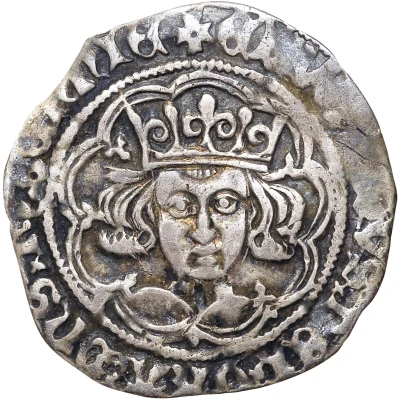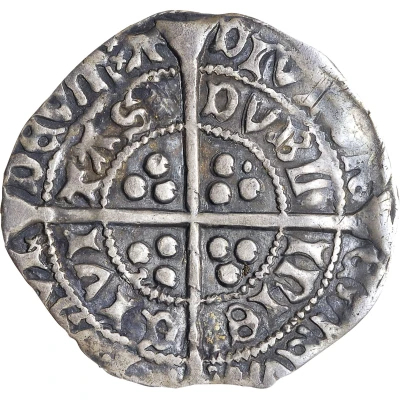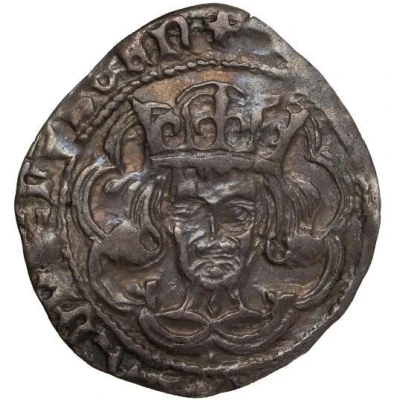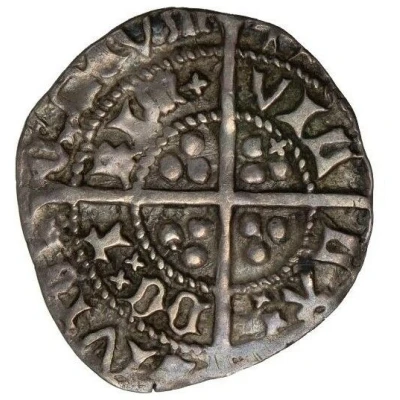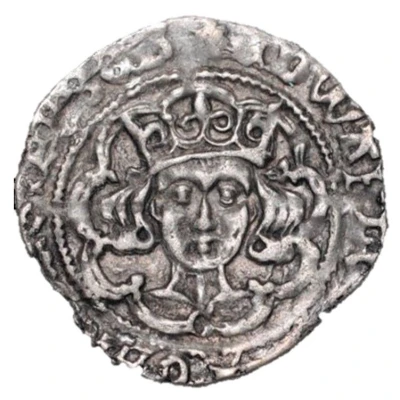


© Davissons Ltd
1 Groat - Edward IV Light cross coinage; Drogheda ND
| Silver | 2.0 g | 23 mm |
| Issuer | Ireland |
|---|---|
| Lord | Edward IV (1461-1483) |
| Type | Standard circulation coin |
| Years | 1472-1478 |
| Value | 1 Groat (1⁄60) |
| Currency | Second Irish Pound (1460-1826) |
| Composition | Silver |
| Weight | 2.0 g |
| Diameter | 23 mm |
| Shape | Round (irregular) |
| Technique | Hammered |
| Demonetized | Yes |
| Updated | 2024-10-05 |
| Numista | N#332968 |
|---|---|
| Rarity index | 100% |
Reverse
Long cross pattée dividing double legends, three large pellets in each quadrant, additional annulet in two opposite quadrants
Script: Latin
Lettering:
POSVI DEVM ADIVTOREM MEVM
VILL A DE DROG hEDA
Translation:
I have made God my helper
Villa of Drogheda
Comment
Variants exist with different combinations of additional objects (small pellets and annulets) in the quadrants reverse.The “G” stands for Germyn Lynch, Master of the Mint. Lynch, who flourished in the mid-late 15th century, is recorded as having served as a shipmaster, goldsmith, freeman and alderman of London. He was also the Master of the Irish mints – a post from which he was dismissed five times on account of making lightweight coins, such as the issue above
Apart from having its own mint, where coins of the realm were produced, the Irish Parliament convened at Drogheda several times during the period 1472-78, i.e. at the time these coins were minted. Drogheda had only recently received its charter (Borough of Drogheda Act, 1467) and had its first Lord Mayor (Mayor of Drogheda Act, 1467). The later addition of a charter for a mint would be a huge boost to the local economy.
1475 (21 July) William, Bishop of Meath and deputy to George, Duke of Clarence (and Lord Deputy) held a parliament at Drogheda. He had replaced Kildare as Chancellor and the king sent him 220 archers in April, to enforce the king’s will on Ireland.
A mint was authorised for Drogheda in 1475. The coins issued here were lighter and contained less silver than those in England. This stopped them from being used outside of Ireland and helped preserve the amount of coins in circulation in Ireland at this time. The year 1475 was an interesting year for Ireland. The Butlers (of Ormond) rose to power and the Fitzgeralds (the Geraldines of Kildare) fell from grace (having been on opposite sides in the continuing Wars of the Roses). Pope Sextus IV issued a Papal Bull on May 5th for the foundation of a university in Dublin to John Walton, Archbishop of Dublin. Walton had a brief to re-establish it; but nothing practical seems to have been done to comply. A university had already been established in 1320. Its campus was located at St Patrick’s Cathedral. Three Doctors of Theology were appointed . It maintained an intermittent existence for the next two centuries, but shortage of funds ensured it never flourished. No graduates were ever recorded. The funds available seem to have been used as extra stipends by the Cathedral
1476 (6 December). Walter FitzSimons (who later became Archbishop of Dublin, 1484-1511) was the Proctor of this Parliament. One of the proclamations from 1476 declared that:“The coin lately made in Cork, Youghal, Limerick and all other places in Munster, except Waterford, being neither lawful in itself nor lawful in weight or alloy, was declared void, and forbidden to be taken in payment." The English king was clearly having problems in controlling money supply and the powers outside of the Pale of Dublin were taking full advantage of his weakness.
1478 (19 November) In 1478, Garret Mór, Earl of Kildare refused to yield the role of Lord Deputy to Lord Grey. A Parliament summoned by Grey at Trim on 6 November 1478 annulled one summoned by Kildare at Naas in May.Proclamations from 1478 declared:Confirmation of appointment of Thomas Archbold, alias Thomas Galmole, as master of the mint in IrelandGovernors of Ireland not to call Parliaments to meet, etc., at any places save Dublin and DroghedaConfirmation of patents appointing the King’s son George Lieutenant of Ireland and Henry Lord Grey, his deputy
Interesting fact
One interesting fact about the 1 Groat - Edward IV (Light cross coinage; Drogheda) ND (1472-1478) coin from Ireland is that it features a unique design element known as a "light cross" on the reverse side, which is a smaller cross pattée within a larger cross pattée. This design was used specifically for coins minted at the Drogheda mint in Ireland during Edward IV's reign.
